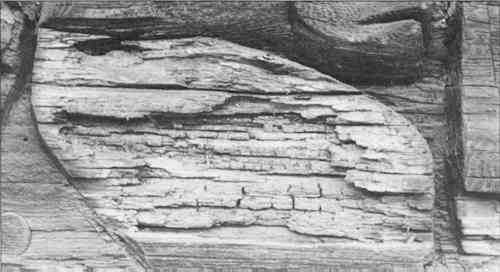AN EPOXY/MICROBALLOON MIXTURE FOR GAP FILLING IN WOODEN OBJECTSR. Barclay, & C. Mathias
1 INTRODUCTIONIT IS A COMMON MISCONCEPTION that the best fill material for degraded wood is new wood, carved and finished to match. This is very rarely true as the reaction of degraded wood to fluctuations in relative humidity is different from that of new wood under similar conditions. There are both physical and chemical reasons for this. In the piece of degraded western red cedar (Thuja plicata) shown in Figure 1 (a section of a totem pole) two separate types of deterioration are present. Near the surface continual wetting and drying due to exposure to weather has created a multitude of radial checks, effectively dividing the surface into discrete zones. Below the surface brown cuboidal rot has caused the wood to lose most of its cellulose. The mechanical properties of each kind of deteriorated wood have changed. In the zoned wood, fluctuations of humidity will cause each small zone, isolated by cracks from adjacent zones, to expand and contract independently with no overall change in dimensions of the whole area. For rotted wood, cellulose, the chief component which reacts strongly to atmospheric moisture, is largely absent. The remaining material will be rather unreactive to moisture and not display normal anisotropic dimensional response. In both instances insertion of new wood could be detrimental. Dimensional changes of the new wood will impose themselves upon the original degraded material and the fill will either detach itself from the underlying wood or damage it.
Wood is also less desirable for fills of the kind required in Figure 1 for two other reasons. Firstly, because of its infinite variety, it is impossible to provide a close match in grain between the new wood and the old. Thus, no matter how carefully fitted, the replacement wood will always obtrude. Secondly, and more importantly, the irregularity of losses in badly degraded wood requires removal of original material in order to ensure a good fit and provide a reasonable gluing surface. Carving a large piece of wood to match the irregularity of large, uneven voids is very difficult. Clearly, a mouldable gap filler with physical characteristics matched to the intended application would be far superior to wood, no matter how carefully and painstakingly the work on the latter were done. It is always important to gain some insight into the condition of the wood to be filled, and to establish a clear understanding of what is required of a gap filler. The following list of criteria may be used to assess the desired qualities:
Until recently few studies had been undertaken on the physical properties of fill materials for wooden objects. Although a wide range of materials have been used by conservators for the filling of obtrusive gaps, little concern has been expressed over the long-term effect of more or less intractable substances on the surrounding wood. A recent extensive study of thirty-three traditionally used gap filling materials and several modern innovations redressed considerably this imbalance.1 The study showed that of all the gap fillers tested, filled silicone rubbers and epoxies presented the most desirable characteristics from the mechanical point of view while also having excellent handling properties. The use of both phenolic microballoons and glass bubbles for loading resins has been described previously in the conservation literature, a paper by Hatchfield2 and a book by Phillips and Selwyn3 being of particular relevance. A description of a filled silicone and its application to wooden objects has been published4 and the present paper has the same goal for the epoxy-based material. |
